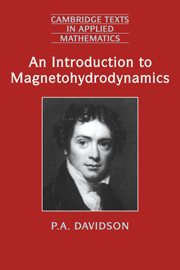Book contents
- Frontmatter
- Contents
- Preface
- Part A The Fundamentals of MHD
- Introduction: The Aims of Part A
- 1 A Qualitative Overview of MHD
- 2 The Governing Equations of Electrodynamics
- 3 The Governing Equations of Fluid Mechanics
- 4 Kinematics of MHD: Advection and Diffusion of a Magnetic Field
- 5 Dynamics at Low Magnetic Reynolds Numbers
- 6 Dynamics at Moderate to High Magnetic Reynolds' Number
- 7 MHD Turbulence at Low and High Magnetic Reynolds Number
- Part B Applications in Engineering and Metallurgy
- Appendices
- Bibliography
- Subject Index
Introduction: The Aims of Part A
Published online by Cambridge University Press: 26 February 2010
- Frontmatter
- Contents
- Preface
- Part A The Fundamentals of MHD
- Introduction: The Aims of Part A
- 1 A Qualitative Overview of MHD
- 2 The Governing Equations of Electrodynamics
- 3 The Governing Equations of Fluid Mechanics
- 4 Kinematics of MHD: Advection and Diffusion of a Magnetic Field
- 5 Dynamics at Low Magnetic Reynolds Numbers
- 6 Dynamics at Moderate to High Magnetic Reynolds' Number
- 7 MHD Turbulence at Low and High Magnetic Reynolds Number
- Part B Applications in Engineering and Metallurgy
- Appendices
- Bibliography
- Subject Index
Summary
Magnetohydrodynamics (MHD for short) is the study of the interaction between magnetic fields and moving, conducting fluids. In the following seven chapters we set out the fundamental laws of MHD. The discussion is restricted to incompressible flows, and we have given particular emphasis to the elucidation of physical principles rather than detailed mathematical solutions to particular problems.
We presuppose little or no background in fluid mechanics or electromagnetism, but rather develop these topics from first principles. Nor do we assume any knowledge of tensors, the use of which we restrict (more or less) to Chapter 7, in which an introduction to tensor notation is provided. We do, however, make extensive use of vector analysis and the reader is assumed to be fluent in vector calculus.
The subjects covered in Part A are:
qualitative overview of MHD
governing equations of electrodynamics
governing equations of fluid mechanics
kinematics of MHD: advection and diffusion of a magnetic field
at low magnetic Reynolds' number
at high magnetic Reynolds' number
turbulence at low and high magnetic Reynolds' numbers
One point is worth emphasising from the outset. The governing equations of MHD consist simply of Newton's laws of motion and the pre-Maxwell form of the laws of electrodynamics. The reader is likely to be familiar with elements of both sets of laws and many of the phenomena associated with them.
- Type
- Chapter
- Information
- An Introduction to Magnetohydrodynamics , pp. 1 - 2Publisher: Cambridge University PressPrint publication year: 2001

